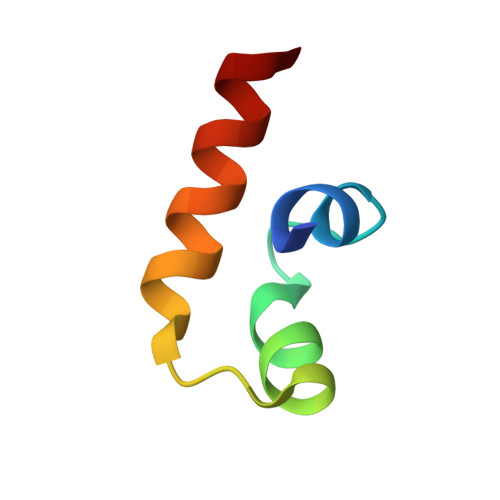Molecular Characterisation of Titin N2A and Its Binding of CARP Reveals a Titin/Actin Cross-linking Mechanism.
Zhou, T., Fleming, J.R., Lange, S., Hessel, A.L., Bogomolovas, J., Stronczek, C., Grundei, D., Ghassemian, M., Biju, A., Borgeson, E., Bullard, B., Linke, W.A., Chen, J., Kovermann, M., Mayans, O.(2021) J Mol Biology 433: 166901-166901
- PubMed: 33647290
- DOI: https://doi.org/10.1016/j.jmb.2021.166901
- Primary Citation of Related Structures:
7NIP - PubMed Abstract:
Striated muscle responds to mechanical overload by rapidly up-regulating the expression of the cardiac ankyrin repeat protein, CARP, which then targets the sarcomere by binding to titin N2A in the I-band region. To date, the role of this interaction in the stress response of muscle remains poorly understood. Here, we characterise the molecular structure of the CARP-receptor site in titin (UN2A) and its binding of CARP. We find that titin UN2A contains a central three-helix bundle fold (ca 45 residues in length) that is joined to N- and C-terminal flanking immunoglobulin domains by long, flexible linkers with partial helical content. CARP binds titin by engaging an α-hairpin in the three-helix fold of UN2A, the C-terminal linker sequence, and the BC loop in Ig81, which jointly form a broad binding interface. Mutagenesis showed that the CARP/N2A association withstands sequence variations in titin N2A and we use this information to evaluate 85 human single nucleotide variants. In addition, actin co-sedimentation, co-transfection in C2C12 cells, proteomics on heart lysates, and the mechanical response of CARP-soaked myofibrils imply that CARP induces the cross-linking of titin and actin myofilaments, thereby increasing myofibril stiffness. We conclude that CARP acts as a regulator of force output in the sarcomere that preserves muscle mechanical performance upon overload stress.
- Department of Biology, University of Konstanz, 78457 Konstanz, Germany.
Organizational Affiliation:
















